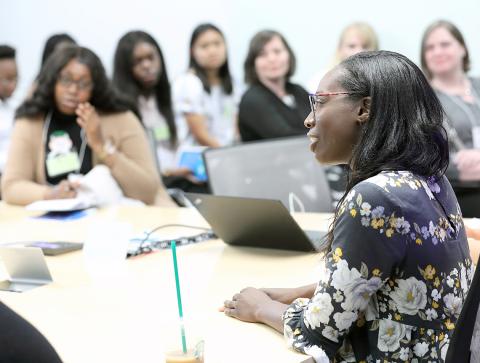NINDS Program Helps STEM Students Navigate Neuroscience

Photo: Chia-Chi Charlie Chang
For high school science students, imagining an actual career in science may seem like a far-off dream. But one NINDS program is working to make that dream a reality. The NINDS Girls Navigating Neuroscience program helps female STEM students develop and nurture their excitement about science while at the same time showing them that science can be accessible and fun.
NINDS recently hosted more than 35 female STEM students from three Prince George’s County public high schools—Charles H. Flowers, Eleanor Roosevelt and Oxon Hill—for a day of scientific presentations, career advice, laboratory tours and hands-on activities.
The year-long program, part of a partnership between the NINDS Office of Programs to Enhance Neuroscience (OPEN) Workforce Diversity, Young Women in Bio and PGCPS, consists of 4 events (3 of which took place earlier in the year at the schools) and strives to get diverse female STEM students interested in careers in science, specifically neuroscience. The long-term goals are to encourage students to apply for the NIH Summer Internship Program and to help develop a diverse biomedical research workforce for the future.
After a welcome by Dr. Rita Devine, assistant director of science administration in the NINDS Division of Intramural Research, and Dr. Angel de la Cruz Landrau, coordinator of the Summer Internships, Diversity and Postbacs Program in the office of NINDS’s scientific director, the students heard a talk from NIH Academy director Dr. Shauna Clark.

Photo: Chia-Chi Charlie Chang
As an undergraduate on a full scholarship at Texas A&M, Clark majored in biochemistry and earned spending money by taking part in the work-study program—working in 3 different laboratories along the way. “My interest in doing research blossomed as an undergrad when I worked in the labs with different people on different projects,” Clark said. “And I discovered that I really liked lab work.”
Clark went on to earn a bachelor of science degree and then to pursue a Ph.D. in infectious diseases and microbiology from the Graduate School of Public Health at the University of Pittsburgh, where her work focused on HIV drug resistance. The experience provided her with an interesting and well-rounded education because it mixed public health with lab work. She came to NIH as a postdoc working on hepatitis C research.
Eventually, she also got involved in mentoring and found she liked it even better than lab work. Clark now teaches about health disparities at the NIH Academy. “As you move through your career, you’ll keep evaluating and reassessing what’s important to you,” she explained.

Photo: Chia-Chi Charlie Chang
Students were then divided into small groups—each led by an NINDS volunteer—and toured labs in Bldgs. 35, 49 and 10.
During the tours, students were given a brief overview of each lab and its focus and allowed to perform a hands-on activity.
In one lab studying the visual system of the fruit fly, students were able to look at different types of live flies—white-eye, red-eye, straight-wing and curly-wing—through a dissecting microscope.
In other labs, students learned about neuronal electrophysiology—the study of electrical properties of cells and tissues within the nervous system, DNA amplification and analysis and NINDS’s current research on disorders such as hereditary spastic paraplegia and muscular dystrophy.
Students also got to see and use many different types of lab equipment including DNA sequencing and cryostat machines and a microscopy room where they were able to view images of brain cells.
As the young women assembled after lunch, they were greeted by NINDS scientific director Dr. Lorna Role.
“I hope you stay with it [science],” she said. “The sooner you start and the sooner you get into it, the more likely you are to stay with it. It’s an incredible trip to be a scientist.”

Photo: Chia-Chi Charlie Chang
Final events included a student panel featuring two NINDS postbacs—Melanie Delgado and Ashley Williams—and a presentation from Dr. Edjah Nduom, an NINDS neurosurgeon-oncologist.
Delgado and Williams each shared how their early interest in science developed through the years and how they took advantage of different opportunities in high school and college to nurture those interests—which eventually led them to their present-day careers here. The young scientists also provided advice on how to pursue science careers. Key messages included the importance of networking, creating and sharing your story and being persistent. Informal sessions followed each presentation during which students were encouraged to ask for career advice or about current research projects.
In addition to Nduom’s ever-popular brain surgery videos, he shared how he started out pursuing physics and ended up as a neurosurgeon conducting research. “Some of it was luck,” he said of his career journey. “A lot of it was opportunity and a lot of it was perseverance.”
